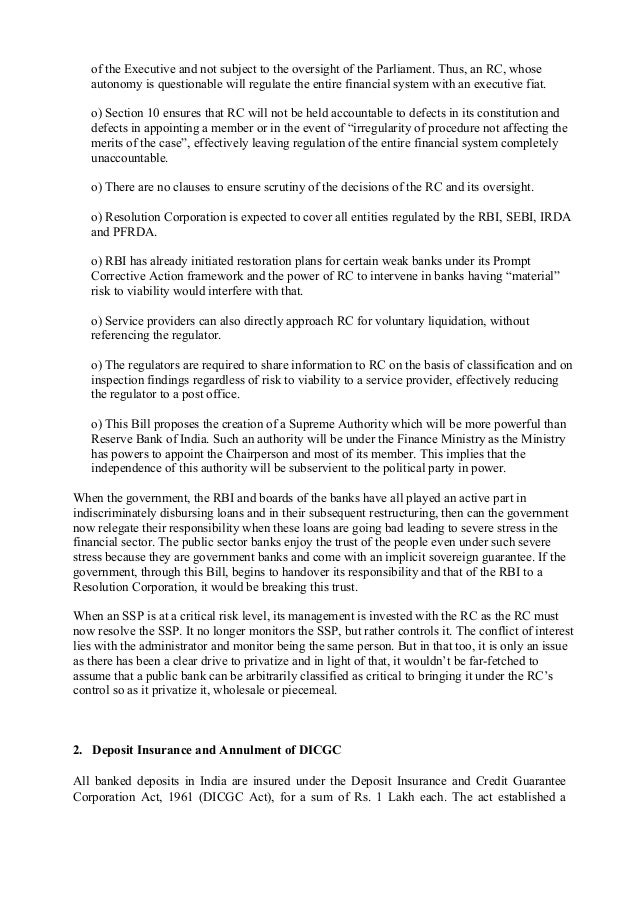Dicgc Act

Published on Sep 03, 2020
The preamble of the Deposit Insurance and Credit Guarantee Corporation Act, 1961 states that it is an Act to provide for the establishment of a Corporation for the purpose of insurance of deposits and guaranteeing of credit facilities and for other matters connected therewith or incidental thereto. The functions of the DICGC are governed by the provisions of 'The Deposit Insurance and Credit Guarantee Corporation Act, 1961' (DICGC Act) and 'The Deposit Insurance and Credit Guarantee Corporation General Regulations, 1961' framed by the Reserve Bank of India in exercise of the powers conferred by sub-section (3) of Section 50 of the said Act. The Preamble of the DICGC Act, 1961 states that it is an act to provide for the establishment of a corporation for the purpose of insurance of deposits and guarantee of credit facilities and for other matters connected therewith or incidental thereto.
Abstract
The concept of insuring deposits kept with banks received attention for the first time in the year 1948 after the banking crisis in Bengal . The issue came up for reconsideration in the year 1949, but was held in abeyance till the Reserve Bank ensured adequate arrangements for inspection of banks.
Subsequently, in the year 1950, the Rural Banking Enquiry Committee supported the concept. Serious thought to insuring deposits was, however, given by the Reserve Bank and the Central Government after the crash of the Palai Central Bank Ltd., and the Laxmi Bank Ltd. in 1960. The Deposit Insurance Corporation (DIC) Bill was introduced in Parliament on August 21, 1961 . After it was passed by Parliament, the Bill got the assent of the President on December 7, 1961 and the Deposit Insurance Act, 1961 came into force on January 1, 1962 . Deposit Insurance Scheme was initially extended to functioning commercial banks only. This included the State Bank of India and its subsidiaries, other commercial banks and the branches of the foreign banks operating in India .
With the enactment of the Deposit Insurance Corporation (Amendment) Act, 1968, the Corporation was required to register 'eligible cooperative banks' as insured banks under the provisions of Section 13 A of the DICGC Act. The Government of India, in consultation with the Reserve Bank, introduced a credit guarantee scheme in July 1960. The Reserve Bank was entrusted with the administration of the scheme, as an agent of the Central Government, under Section 17 (11 A)(a) of the Reserve Bank of India Act, 1934 and was designated as the Credit Guarantee Organization (CGO) for guaranteeing the advances granted by banks and other credit institutions to small scale industries. The Reserve Bank operated the scheme up to March 31, 1981 . The Reserve Bank also promoted a public limited company on January 14, 1971 , named the Credit Guarantee Corporation of India Ltd. (CGCI).
The credit guarantee schemes introduced by the Credit Guarantee Corporation of India Ltd., aimed at encouraging the commercial banks to cater to the credit needs of the hitherto neglected sectors, particularly the weaker sections of the society engaged in non-industrial activities, by providing guarantee cover to the loans and advances granted by the credit institutions to small and needy borrowers covered under the priority sector as defined by the RBI. With a view to integrating the functions of deposit insurance and credit guarantee, the above two organizations (DIC & CGCI) were merged and the present Deposit Insurance and Credit Guarantee Corporation (DICGC) came into existence on July 15, 1978. Consequently, the title of Deposit Insurance Act, 1961 was changed to 'The Deposit Insurance and Credit Guarantee Corporation Act, 1961'. Effective from April 1, 1981 , the Corporation extended its guarantee support to credit granted to small scale industries also, after the cancellation of the Government of India's credit guarantee scheme. With effect from April 1, 1989 , guarantee cover was extended to the entire priority sector advances.
Objective of the Project
The objective of the project can be summarized as follows-
• i. To understand the role of Urban co-operative bank
• ii. To understand the basic concept of deposit insurance in bank and related issues

A Descriptive Research has been carried out wherein data has been extensively gathered from various Sources pertaining to Deposit insurance. The data was gathered by secondary sources mention below.
Secondary data has been collected from RBI's website for information on Indian Banking Industry particularly cooperative banks. DICGC website was also source of secondary data for method of premium calculation & claim Settlement.Secondary data has been collected by visiting the ledgers of the bank, Statutory Audit report of the Bank for the Year 2007 & 2008
Type Of Deposits Covered
The Corporation insures all bank deposits, such as savings, fixed, current, recurring, etc. except the deposits of (i) foreign governments; (ii) Central/State Governments; (iii)State Land Development Banks with the State co-operative banks; as also (iv) inter-bank deposits (v) deposits received outside India and (vi) deposit specifically exempted by the Corporation with the previous approval of the Reserve Bank.
INSURANCE PREMIUM
The Corporation collects insurance premium from insured banks for administration of the deposit insurance system. The premium to be paid by the insured banks is computed on the basis of their assessable deposits. Insured banks pay advance insurance premium to the Corporation annually, within two months from the beginning of each financial year based on its deposits as at the end of previous half year. The premium paid by the insured banks to the Corporation is required to be borne by the banks themselves and is not passed on to the depositors.
For delay in payment of premium, an insured bank is liable to pay interest at the rate of 8 per cent above the Bank Rate on the default amount from the beginning of the relevant half-year till the date of payment.
Settlement of Claims
1. The Reserve Bank cancels the licence / rejects the application for licence of a bank and recommends its liquidation to the concerned
Registrar of Co-operative Societies (RCS) with endorsement to the DICGC
2. The RCS appoints a Liquidator for the liquidated bank with endorsement to the DICGC.
3. The DICGC cancels the registration of the bank as an insured bank and issues guidelines for submission of the claim list by the liquidator within 3 months and requests Reserve Bank to appoint an external auditor [Chartered Accountant, (C.A)] for on-site verification of the list.
4. The Reserve Bank appoints C.A. and the DICGC conducts briefing and orientation session for C.A. to check the claim list.
5. The Liquidator submits the claim list for payment to the depositors (both hard and soft forms).
6. The external auditors ( C.A. ) submit their report on the aspects of the claim list.
7. The claim list is computer-processed and payment list is generated.
8. Consolidated payment is released to the Liquidator and further information sought on incomplete/doubtful claims. The release of claims is announced through the website of the Corporation.
9. The liquidator releases the payment to the depositors.
Reference :
Source: Annual report of DICGC 2008-09
www.rbi.org.in
www.digc.org.in
www.bankrate.com

Deposit Insurance
Dicgc Act India
Banks covered by Deposit Insurance Scheme
(I) All commercial banks including the branches of foreign banks functioning in India, Local Area Banks and Regional Rural Banks.
(II) Co-operative Banks - All eligible co-operative banks as defined in Section 2(gg) of the DICGC Act are covered by the Deposit Insurance Scheme. All State, Central and Primary co-operative banks functioning in the States/Union Territories which have amended their Co-operative Societies Act as required under the DICGC Act, 1961, empowering RBI to order the Registrar of Co-operative Societies of the respective States/Union Territories to wind up a co-operative bank or to supersede its committee of management and requiring the Registrar not to take any action for winding up, amalgamation or reconstruction of a co-operative bank without prior sanction in writing from the RBI, are treated as eligible banks. At present all Co-operative banks are covered by the Scheme. The Union Territories of Lakshadweep and Dadra and Nagar Haveli do not have Co-operative Banks.
Registration of new banks as insured banksz
Under Section 11 of the DICGC Act, 1961, all new commercial banks are required to be registered as soon as may be after they are granted licence by the Reserve Bank of India under Section 22 of the Banking Regulation Act, 1949.
Following the enactment of the Regional Rural Banks Act, 1976 all Regional Rural Banks are required to be registered within 30 days from the date of their establishment in terms of Section 11A of the DICGC Act, 1961.

Dicgc Act 1961
Co-operative Banks - A new co-operative bank is required to be registered as soon as may be after it is granted a licence by the RBI.
A primary co-operative credit society becoming a primary co-operative bank is to be registered within 3 months from the date of its application for licence.
A co-operative bank which has come into existence after the commencement of the Deposit Insurance Corporation (Amendment) Act, 1968, as a result of the division of any other co-operative society carrying on business as a co-operative bank, or the amalgamation of two or more co-operative societies carrying on banking business at the commencement of the Banking Laws (Application to Co-operative Societies) Act, 1965 or at any time thereafter is to be registered within three months of its making an application for licence.
However, a co-operative bank will not be registered, if it has been informed by the RBI in writing that a licence cannot be granted to it.
In terms of Section 14 of the DICGC Act, after the Corporation registers a bank as an insured bank, it is required to send, within 30 days of the bank's registration, an intimation in writing to the bank that it has been registered as an insured bank.
The letter of intimation, apart from the advice of registration and registration number, gives the details about the requirements to be observed by the bank, the rate of premium payable to the Corporation, the manner in which the premium is to be paid by the bank and the returns to be furnished to the Corporation etc. The insured bank has to submit its first return and remit the amount of premium within one month from the receipt of the letter, which is dispatched by Registered post or the date of commencement of business whichever is later. A copy of this letter is endorsed to the Reserve Bank of India and also National Bank For Agriculture and Rural Development (NABARD) in the case of Regional Rural Banks/State co-operative banks and District Central co-operative banks.
Insurance coverage
IInitially, under the provisions of Section 16(1) of the DICGC Act, the insurance cover was limited to 1,500/- only per depositor(s) for deposits held by him (them) in the 'same right and in the same capacity' in all the branches of the bank taken together. However, the Act also empowers the Corporation to raise this limit with the prior approval of the Central Government. Accordingly, the insurance limit was enhanced from time to time as follows:
>> 5,000/- with effect from 1st January 1968
>> 10,000/- with effect from 1st April 1970
>> 20,000/- with effect from 1st January 1976
>> 30,000/- with effect from 1st July 1980
>> 1,00,000/- with effect from 1st May 1993 onwards.
Types of Deposits Covered
DICGC insures all bank deposits, such as saving, fixed, current, recurring, etc. except the following types of deposits.
(i) Deposits of foreign Governments;
(ii) Deposits of Central/State Governments;
(iii) Inter-bank deposits;
(iv) Deposits of the State Land Development Banks with the State co-operative banks;
(v) Any amount due on account of and deposit received outside India;
(vi) Any amount which has been specifically exempted by the corporation with the previous approval of the RBI.